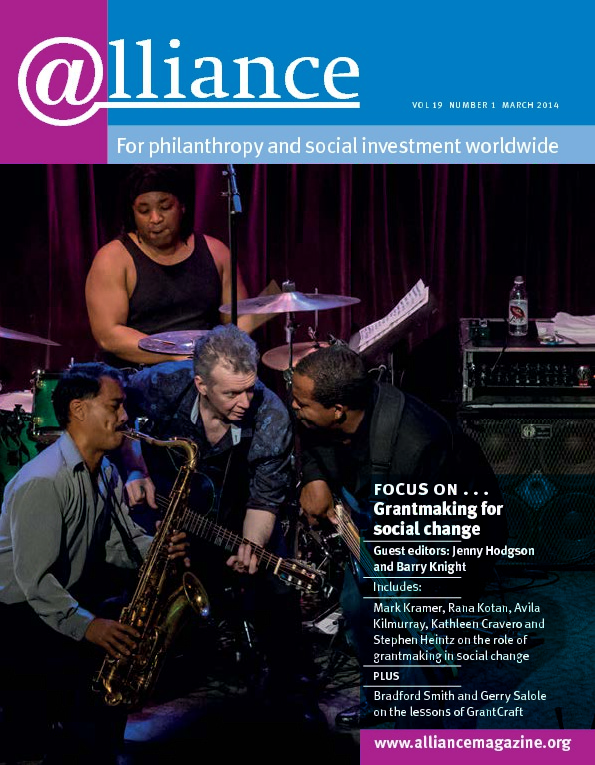This year has been hailed as the year that impact investing comes of age, with the G8 Report in September as the likely watershed. Having specialized in financial product development with Coutts and Kleinworts for 11 years and then worked for Ashoka and Total Impact Advisors, this is a development I very much welcome. My experience has also convinced me that two things are necessary: getting the intermediary and legal framework right; and ensuring that the social mission is hardwired into the for-profit structures involved.
Why? Because not only are public or private subsidies involved, but cross-subsidization between economic and social mission lies at the heart of impact investing. As with all financial products, the questions are: who is taking the risk and who will take the profit? And who is making that judgement? Where incentives (bonus and subsidy), metrics (ratings agency and social metrics) and accountability (regulation) are misaligned, the results, as we saw in the 2008 financial crisis, can be disastrous.
Social impact bonds, which are evolving into DIBs (development impact bonds) or what we at Total Impact Advisors call SYNs (social yield notes – effectively equity), are cross-sector partnership instruments with payment based on the achievement of tangible, auditable social goals – which reinforce this multi-player dimension of risk and return.
In addition, the more forward-looking institutions are addressing these social issues on a systems basis. As an example, at Total Impact Advisors we have recently completed a report with the Rockefeller Foundation which looks systemically at the issue of resilience. We identified six areas in which financial innovation could stimulate greater efficiency and impact, including incentivizing the creation of multi-stakeholder partnership hubs. This development is also being driven by ‘big data’ and increased accessibility of information technology.
In 2013, we published a UN ESCAP Report based on work we did with WSP, WSSCC, UNICEF, a leading social entrepreneur and two McKinsey teams using sanitation as a case study, to outline the opportunities of impact investing and outcome models. We are developing that work in areas like the environment, road safety, health and education.[1]
All this work indicates that there are three current sacred cows that impact investing needs to seriously question.
First, the idea that impact investing is a single asset class. This is demonstrably false. As noted above, there is a huge range of financial innovation being applied to the sector. To view the intermediary and legal framework through just a bilateral VC and/or PE model will constrain other innovation and is simplistic at best, distorting at worse.
Second, the idea that the inclusion of social metrics will necessarily maximize social return. But social metrics is not unitary. There are four hidden values (what bankers call Alpha) in the sector’s metrics at present:
1 Social entrepreneurship and innovation
2 Financial innovation
3 Economies of scale in a highly fragmented sector
4 Collaboration in a system in which it has historically been very low
The size of Alphas 2, 3 and 4 in our sector is large. One can see this in existing collaborative structures such as the US Community Reinvestment Act or in the GAVI model where the unit cost of vaccinations dropped from $50 to $5. In these public private-partnerships the social mission is hardwired. In impact investing, who will capture this value and ensure maximization of the margin to the social players?
Third, the idea that the legal framework is simply an ‘add-on’. It is the basis for ensuring the integrity of impact investing. Without it, we will be building on sand with conflicts of interest rife and no way of ensuring the social mission is hardwired.
In the rush to engage the banks, we need to safeguard the charitable sector by agreeing on exactly how much money and margin we are prepared to give away in these structures in a transparent manner. What is the contractual, and preferably regulatory, facilitation mechanism? This is not just a bilateral social venture capital model with a ‘primary contractor’ dictating terms. Where is the independent intermediary framework to support the social entrepreneurs as primary contractors?
As an alternative, I suggest we look for structures in which intermediary and legal solutions facilitate genuine partnership, transparently address conflicts of interest, empower the social sector, leverage innovation, create modular transparent compliance for government and genuinely hardwired social mission in the long-term interests of the sector and society.
1 http://www.unescap.org/esd/publications/water/2013/the-case-of-sanitation-in-asia/Sanitation-Report-FINAL.pdf
http://www.accenture.com/SiteCollectionDocuments/PDF/Accenture-Investment-Global-Education.pdf
Arthur Wood is a founding partner at Total Impact Advisors. Email awood@totalimpactadvisors.com






Comments (0)